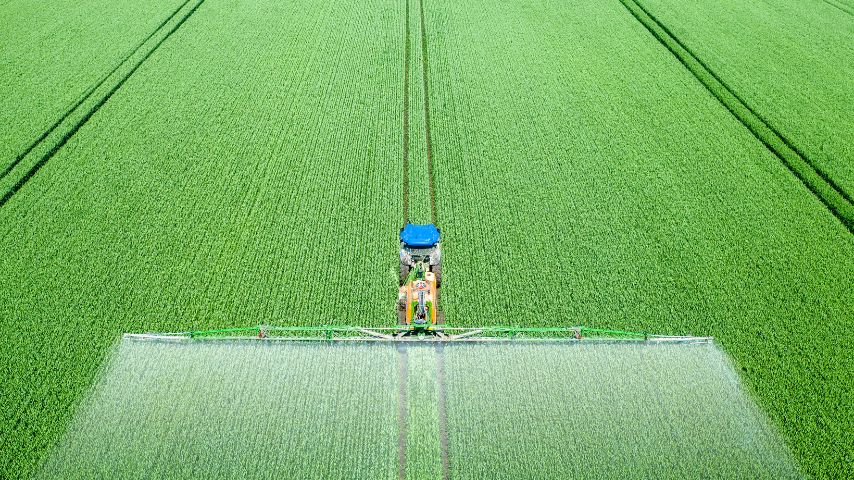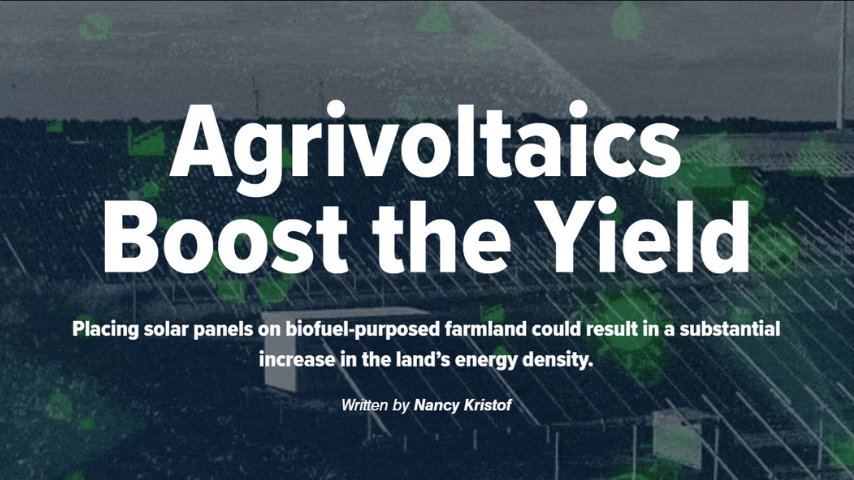Engineers Revolutionize Pesticide Application to Reduce Runoff
Engineers Revolutionize Pesticide Application to Reduce Runoff


An MIT professor has developed a new spray nozzle that cloaks chemical pesticides in a thin layer of natural oil. This solution stops the chemicals from bouncing off plant surfaces and being wasted.
It was in 2012 while working for the U.S. Department of Agriculture, that Kripa Varanasi first learned about pesticide runoff and the damaging impact it can have on the environment and drinking water. Nowadays, about $60 billion worth of pesticides are spread annually worldwide, and they aren’t nearly as effective as they could be.
“Believe it or not, under five percent of pesticides are retained by plants,” Varanasi explained. “We are spraying a lot, but most plant surfaces are hydrophobic and actually repel droplets, so those chemicals are affecting the soil, they are seeping into aquifers, and they are impacting the farmers’ long-term health. But if the farmers don’t use pesticides at all, wildlife will eat all the produce.”
In response to this Catch 22, Varanasi, now a professor of mechanical engineering at MIT, has developed a multi-staged solution. The first is a new nozzle that cloaks the chemical in a thin layer of natural oil to stop it from bouncing straight off the plant. When compared to a conventional sprayer, they found that the new nozzle effectively covers the plant in the pesticide.
“So we’re not changing anything with the pesticide, but we are changing the carrier that's bringing them to the plant,” he said.
They tested the cloaking method under a variety of circumstances to understand how the oiled droplets would interact with the plants. Overall, the team reported a remarkable advancement in spray technology achieving up to a 102-fold increase in retention on water-repellent surfaces and slashed waste by up to 5-fold when used on actual crop leaves.
As for the oil they used, they tried many food-safe oils, including soybean oil, and ultimately determined that the type of oil doesn’t make much of a difference—meaning a farmer could theoretically use any kind of oil they had on hand, often called a surfactant or adjuvant in the industry.
However, while surfactants are commonly used to improve spray coverage, their effectiveness in preventing droplet rebound is not widely understood and can actually increase drift and runoff by reducing droplet size and accelerating evaporation which leads to product loss and can even pose greater environmental and biological risks than the pesticides themselves. Varanasi explained that they are eager to see how they can further optimize this process by not only working with the farms, but the chemical companies, as well, to reduce these hazards.
In the second stage of development, Varanasi and his team went to the farms to run trials on the nozzle. When talking to farmers, they learned about their current testing methods and found that the main method, which involves spraying the pesticide onto a card to measure its coverage that doesn’t have the same properties as the leaves of their crops. The cards aren’t hydrophobic and therefore are not good indicators of how effective a spray is.
“There’s no correlation between the current measurement techniques and the efficiency of the product,” Varanasi reported. “So they’re spraying blind.”
To solve this side of the issue, the team developed another device that can be retrofitted to a boom sprayer. As the farmer is spreading the pesticide, the device measures in real time the coverage that the farmer is getting so they may reduce or increase the amount they are spraying, creating the industry’s “first feedback-optimized spraying technology.”
“We’ve been applying this all over the heartland of America,” Varanasi said. “Farmers have trouble changing their processes. Margins are already so slim. But seeing this data, they say it’s a no-brainer for them to switch. They are seeing significant savings. It’s a win-win for farmers and consumers.”
 Varanasi and his team created a business called AgZen to commercialize the products and they currently have 38 farms they’re working with across the world, totaling just under one million acres of land.
Varanasi and his team created a business called AgZen to commercialize the products and they currently have 38 farms they’re working with across the world, totaling just under one million acres of land.
With this new method of ubiquitously delivering chemicals across large areas of space, they also see the potential to influence other industries, with applications in sanitation, de-icing of airplanes, and coating solar panels.
As this technology expands its reach across farmlands and potentially into other industries, the vision of a more precise application of vital chemicals moves closer to reality, showing how the ingenuity of engineers can tackle complex global issues.
Cassandra Kelly is a technology writer in Columbus, Ohio.
“Believe it or not, under five percent of pesticides are retained by plants,” Varanasi explained. “We are spraying a lot, but most plant surfaces are hydrophobic and actually repel droplets, so those chemicals are affecting the soil, they are seeping into aquifers, and they are impacting the farmers’ long-term health. But if the farmers don’t use pesticides at all, wildlife will eat all the produce.”
Multi-stage engineering solution
In response to this Catch 22, Varanasi, now a professor of mechanical engineering at MIT, has developed a multi-staged solution. The first is a new nozzle that cloaks the chemical in a thin layer of natural oil to stop it from bouncing straight off the plant. When compared to a conventional sprayer, they found that the new nozzle effectively covers the plant in the pesticide.
“So we’re not changing anything with the pesticide, but we are changing the carrier that's bringing them to the plant,” he said.
They tested the cloaking method under a variety of circumstances to understand how the oiled droplets would interact with the plants. Overall, the team reported a remarkable advancement in spray technology achieving up to a 102-fold increase in retention on water-repellent surfaces and slashed waste by up to 5-fold when used on actual crop leaves.
As for the oil they used, they tried many food-safe oils, including soybean oil, and ultimately determined that the type of oil doesn’t make much of a difference—meaning a farmer could theoretically use any kind of oil they had on hand, often called a surfactant or adjuvant in the industry.
However, while surfactants are commonly used to improve spray coverage, their effectiveness in preventing droplet rebound is not widely understood and can actually increase drift and runoff by reducing droplet size and accelerating evaporation which leads to product loss and can even pose greater environmental and biological risks than the pesticides themselves. Varanasi explained that they are eager to see how they can further optimize this process by not only working with the farms, but the chemical companies, as well, to reduce these hazards.
In the second stage of development, Varanasi and his team went to the farms to run trials on the nozzle. When talking to farmers, they learned about their current testing methods and found that the main method, which involves spraying the pesticide onto a card to measure its coverage that doesn’t have the same properties as the leaves of their crops. The cards aren’t hydrophobic and therefore are not good indicators of how effective a spray is.
“There’s no correlation between the current measurement techniques and the efficiency of the product,” Varanasi reported. “So they’re spraying blind.”
To solve this side of the issue, the team developed another device that can be retrofitted to a boom sprayer. As the farmer is spreading the pesticide, the device measures in real time the coverage that the farmer is getting so they may reduce or increase the amount they are spraying, creating the industry’s “first feedback-optimized spraying technology.”
Other industry applications
“We’ve been applying this all over the heartland of America,” Varanasi said. “Farmers have trouble changing their processes. Margins are already so slim. But seeing this data, they say it’s a no-brainer for them to switch. They are seeing significant savings. It’s a win-win for farmers and consumers.”

With this new method of ubiquitously delivering chemicals across large areas of space, they also see the potential to influence other industries, with applications in sanitation, de-icing of airplanes, and coating solar panels.
As this technology expands its reach across farmlands and potentially into other industries, the vision of a more precise application of vital chemicals moves closer to reality, showing how the ingenuity of engineers can tackle complex global issues.
Cassandra Kelly is a technology writer in Columbus, Ohio.



.png?width=854&height=480&ext=.png)


